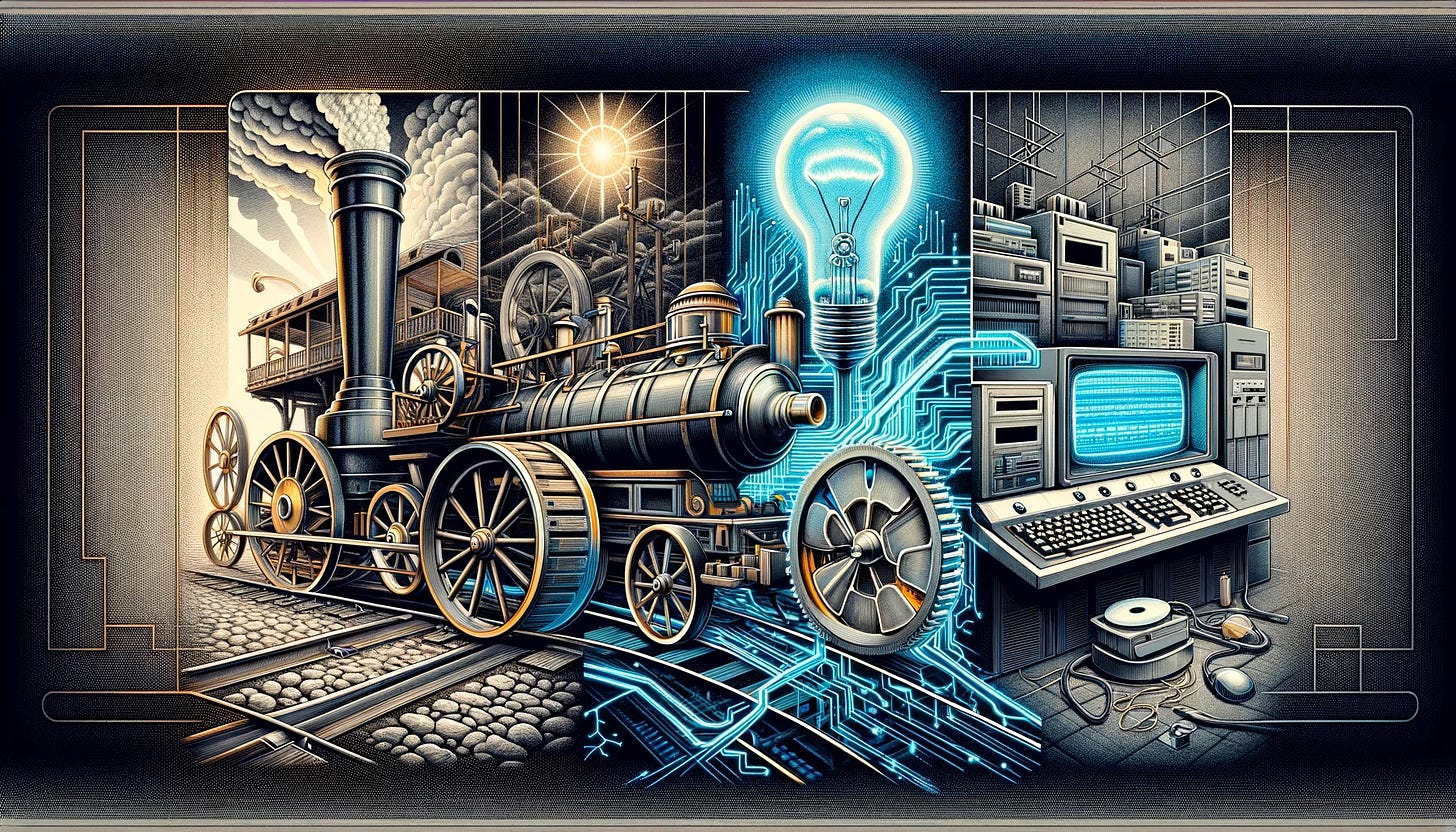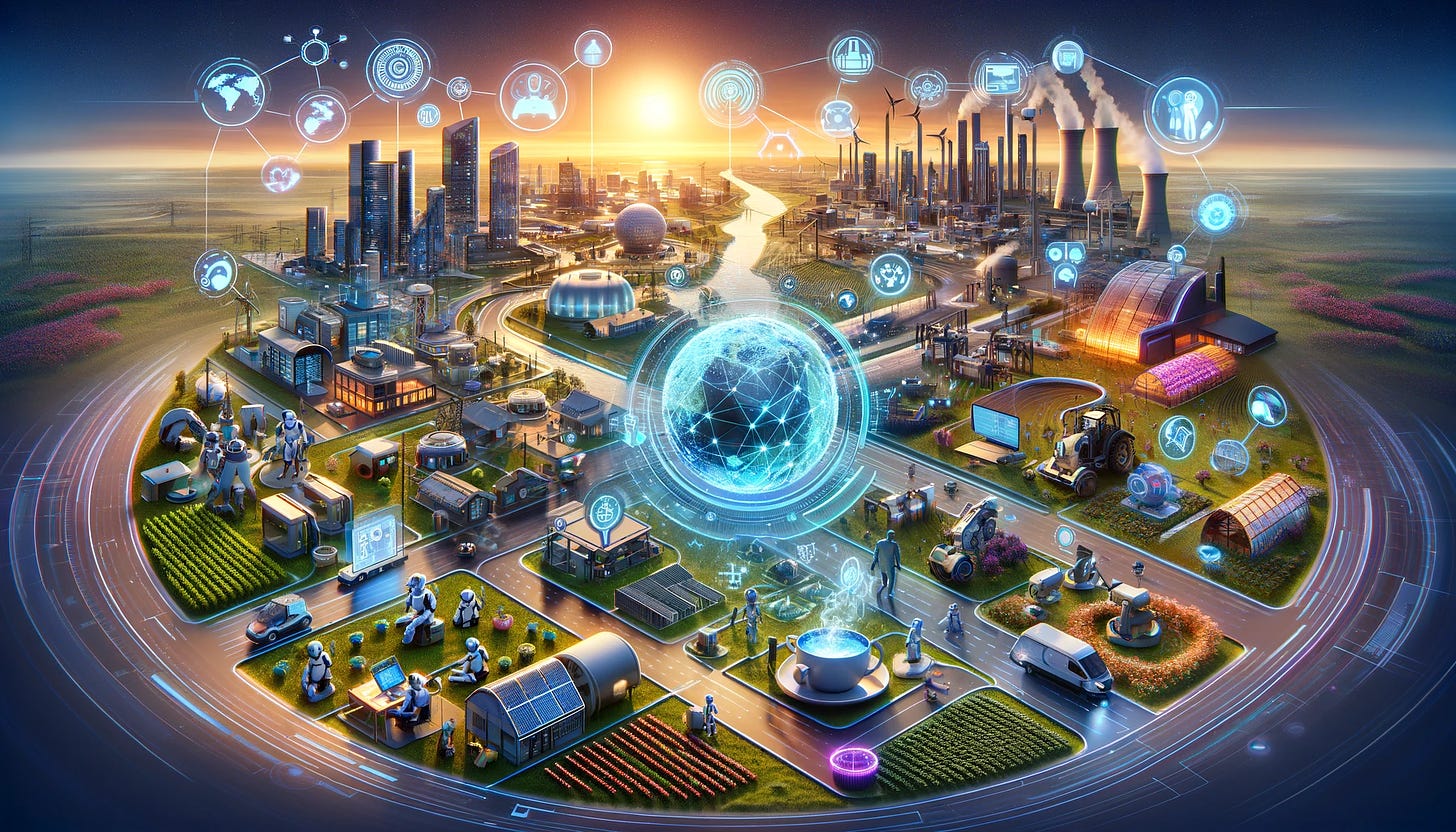Will AI Lead to Creative Destruction in Education?
Welcome to the inaugural post of this newsletter, dedicated to exploring AI in Education. In this first edition, we will take a broader look at Artificial Intelligence, using an economic lens to examine a pivotal question:
Is AI the new General Purpose Technology (GPT) driving sustained economic growth and the harbinger of “creative destruction” in education.
This post is divided into the following sections:
General Purpose Technologies (GPTs) are keys to sustained economic growth: Here, we'll explore how GPTs have historically fueled economic expansions and transformations.
The three defining characteristics of GPTs: This section will cover the essential traits of GPTs, namely pervasiveness, inherent potential for technical improvements, and innovational complementarities.
Artificial Intelligence is emerging as the new GPT: We will discuss how AI is positioning itself as the latest GPT, with potential implications as profound as those of electricity or the steam engine.
Spotlight: Our spotlight shines on Erik Brynjolfsson, the Jerry Yang and Akiko Yamazaki Professor and Senior Fellow at the Stanford Institute for Human-Centered AI (HAI), and Director of the Stanford Digital Economy Lab. This segment will highlight Brynjolfsson's contributions and provide a starting point for further study of AI as a GPT.
General Purpose Technologies (GPTs) are keys to sustained economic growth
In a landmark paper, written in 1995, the economists Timothy F. Bresnahan and Manuel Trajtenberg coined the term “General Purpose Technologies” (GPT) to describe a special class of technologies that spur “whole eras” of technical progress and economic growth.1 Historical examples of GPTs include the steam engine, electricity, and computers.
Economists have long recognized that technological progress is a major driver of economic growth. In 1957, Robert Solow2 formalized the intuition with the Solow-Swan Growth Model, showing that technological progress is key to explaining sustained economic growth. (See MIT Technology Review for a portrait of Solow’s work and career.) While Robert Solow's work recognized the significance of technological progress, it left technology somewhat shrouded in mystery—a bit of a black box, if you will. It was Timothy F. Bresnahan and Manuel Trajtenberg who, with their groundbreaking work on General Purpose Technologies (GPTs), opened up that black box. They not only illuminated the inner workings of technology's role but also showed how GPTs, with their transformative power, could be the missing link in explaining sustained economic growth. Their research not only added depth and detail to our understanding of Solow’s Growth Model but also unveiled the mechanisms behind technological progress, shedding light on the structural changes, productivity gains, and long-term growth potential associated with these transformative technologies.
GPTs are rare and when they come on the scene, they cause significant, widespread impacts across an economy, affecting multiple industries and sectors.
GPTs are not innovations that improve efficiency or effectiveness in a specific area; rather, they are “prime movers” that transform economies and societies at scale.
For better or worse, Artificial Intelligence is the next GPT.
The three defining characteristics of GPTs
As “prime movers”, what makes GPTs different from “run-of-the-mill” technologies? Bresnahan and Trajtenberg defined three salient characteristics of GPTs: pervasiveness, inherent potential for technical improvements, and innovational complementarities across industries.
Let's take a look at each characteristic with the example of electricity.
Pervasiveness refers to the wide-ranging applicability and use of a technology across various sectors and industries. Electricity revolutionized multiple industries and aspects of daily life starting in the 1880s. It quickly became an essential part of residential, commercial, and industrial settings. From lighting homes to powering factories, electricity’s ubiquitous presence transformed the way society functioned. It facilitated the transition from manual labor to mechanized processes, impacting everything from manufacturing to transportation, and even the nature of household chores. The key period for its development and widespread adoption was between the 1880s and the early 1920s.
In 1882 Thomas Edison opened the Pearl Street Station in New York City, the first commercial central power plant in the United Soon after, widespread installation of electrical lighting in urban areas began, gradually replacing gas lighting. This period also saw significant advancements in electrical engineering and the development of alternating current (AC) systems, which were more efficient for long-distance power transmission than the direct current (DC) systems initially used.
In the early part of 20th Century, electrification started to spread beyond lighting, powering industrial motors, public transportation systems (like electric streetcars), and leading to the development of a variety of electric appliances for homes and businesses. By the 1920s, electricity had become a critical infrastructure in urban areas in the United States and Europe, signaling its status as a GPT.A hallmark of GPTs is their potential for improvement over time, becoming more efficient, powerful, and adaptable as the technology becomes pervasive. The evolution of electricity was marked by significant advancements in generation, distribution, and utilization. From the initial direct current (DC) systems to the more efficient alternating current (AC) systems, the technology of electricity generation and distribution underwent substantial improvements. Innovations like the transformer, the electric motor, and the development of nationwide power grids massively enhanced the efficiency and reliability of electricity. Over time, these improvements expanded the scope and scale of electricity's applications, making it more versatile, efficient, and cost-effective.
GPTs also spur complementary innovations which cascade across multiple industries. According to Bresnahan and Trajtenberg, GPTs role as prime-movers stem primarily from the workings of “innovational complementaries”. GPTs spur the development of new industries, technologies, and processes that complement the GPT itself. The widespread adoption of electricity led to the creation of entirely new industries and technological innovations. The electric light bulb, household appliances like refrigerators and washing machines, and later, electronic devices like computers and telecommunications equipment, are all examples of complementary innovations spurred by electricity. These inventions, in turn, created new markets, new forms of entertainment, and even new ways of working and living. The development of these complementary technologies further embedded electricity into the fabric of modern society, illustrating its role as a catalyst for broader economic and technological transformations.
Artificial Intelligence is emerging as the new GPT
The emerging consensus among economists is that Artificial Intelligence (AI) is the modern embodiment of a General Purpose Technology. It exhibits the three key characteristics defined above.
AI's pervasiveness is evident in its widespread adoption across multiple domains. In healthcare, AI is now used for diagnostic procedures and personalized medicine. In finance, it powers algorithmic trading and fraud detection systems. In the automotive industry, AI is at the heart of self-driving car technology but also many of the components of modern cars. It is also transforming consumer products through smart assistants, personalized recommendations in retail and entertainment, and more. This broad spectrum of applications across varied fields underlines AI's pervasive nature.
AI has seen significant improvements over time during the past two decades, marked by several groundbreaking advances. The early 2000s witnessed the rise of machine learning and big data, setting the stage for more complex AI applications. The introduction of deep learning and neural networks, particularly convolutional and recurrent neural networks, revolutionized tasks like image and speech recognition. The 2010s saw the emergence of Generative Adversarial Networks (GANs), enhancing the capability of AI to generate realistic images and content. The development and refinement of natural language processing, exemplified by models like GPT (Generative Pre-trained Transformer), dramatically improved the understanding and generation of human-like text. Additionally, the integration of AI in robotics and autonomous systems, such as self-driving cars and drones, marked a significant leap in practical applications. These advancements, fueled by exponential increases in computational power and data availability, have significantly expanded AI's impact across various sectors, from healthcare to finance.
AI has spurred a multitude of complementary and cascading innovations across various sectors, transforming how we approach and solve complex problems. In healthcare, AI-driven diagnostics and personalized medicine are becoming increasingly prevalent, enabling earlier detection and more effective treatment of diseases. In finance, AI algorithms have revolutionized risk assessment, fraud detection, and algorithmic trading, leading to more secure and efficient financial systems. The field of environmental science has benefited immensely, with AI being used for climate modeling, predicting natural disasters, and managing renewable energy sources more effectively. The transportation sector has seen a surge in innovations with the development of autonomous vehicles and optimized traffic management systems. Moreover, AI's role in cybersecurity has become pivotal in defending against sophisticated cyber threats. Finally, the scientific enterprise is now in its “fourth paradigm” (as articulated by Turing Award winner Jim Gray), where scientific discovery and exploration have moved beyond traditional empirical, theoretical, and computational approaches to enable a new era of data-intensive and algorithmic discovery and insights. These innovations not only represent advancements within their respective fields but also signify a broader shift towards a more interconnected and data-driven future.
Spotlight: Erik Brynjolfsson
In his insightful work, Erik Brynjolfsson, the Jerry Yang and Akiko Yamazaki Professor and Senior Fellow at the Stanford Institute for Human-Centered AI (HAI), and Director of the Stanford Digital Economy Lab, emphasizes a critical aspect of General Purpose Technologies (GPTs) and their impact on productivity and innovation. Brynjolfsson argues that GPTs truly take off and revolutionize industries not merely by their existence but when business processes are reengineered to fully leverage the capabilities of these new technologies. This suggests that the real value of GPTs, such as artificial intelligence or the internet, is unlocked only when organizations rethink and redesign their workflows, decision-making processes, and strategies to align with the technological advancements. It is this synergy between technological innovation and process transformation that catalyzes significant productivity gains and drives forward the frontiers of innovation. Brynjolfsson's work underlines the importance of adaptability and strategic reorientation in the digital age, where technology alone is not a panacea, but a tool that needs to be integrated thoughtfully into the fabric of business operations.
In “The Macroeconomics of Artificial Intelligence”, Brynjolfsson and Gabriel Unger present two potential future paths: a positive scenario where AI boosts productivity, reduces income inequality, and supports small firms, and a negative scenario with low productivity growth, increased income inequality, and higher industrial concentration.
The direction AI takes depends on current technological and policy decisions, emphasizing the need for innovative policy experiments and societal goals to steer AI development towards more beneficial outcomes. The authors highlight the importance of flexible, evolving approaches to AI technology and policy, considering its rapid evolution and profound implications for society.
Conclusion
In conclusion, the emergence of Artificial Intelligence as a General Purpose Technology (GPT), as discussed by Brynjolfsson and Unger, marks a paradigm shift with profound implications. Its pervasive nature, continuous improvement, and capacity to drive complementary innovations position AI as a transformative force, akin to the advent of electricity or the steam engine. In the realm of education, this newsletter's focus, AI promises to catalyze what Joseph Schumpeter termed “creative destruction.” However, this journey, only just beginning, entails not only the redefinition of innovation, efficiency, and human potential boundaries but also presents numerous risks, both known and unknown. By appreciating AI's role as a GPT, as highlighted by Brynjolfsson and Unger, we can better grasp its significance and the diverse ways it will shape our future, establishing it as a critical area for anyone invested in the forefront of developing human potential.
Bresnahan, T. F., & Trajtenberg, M. (1995). General purpose technologies ‘Engines of growth’?. Journal of econometrics, 65(1), 83-108.
Solow, R. M. (1957). Technical change and the aggregate production function. The review of Economics and Statistics, 39(3), 312-320.







